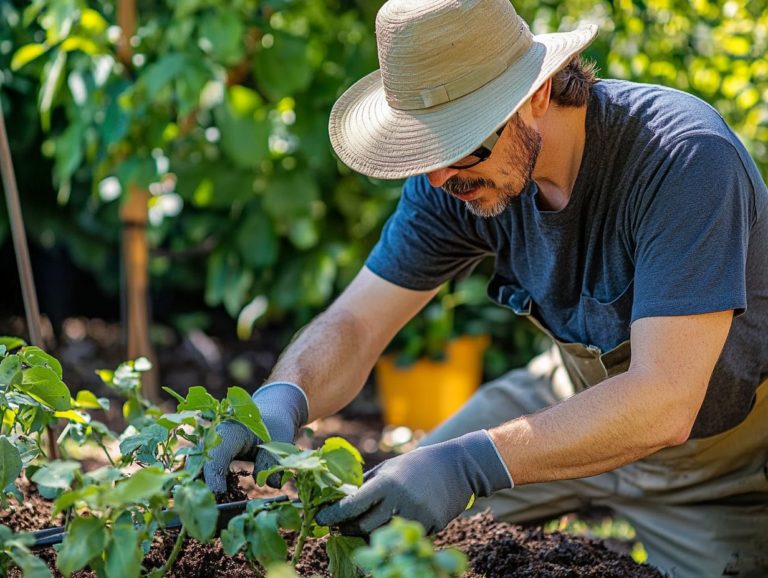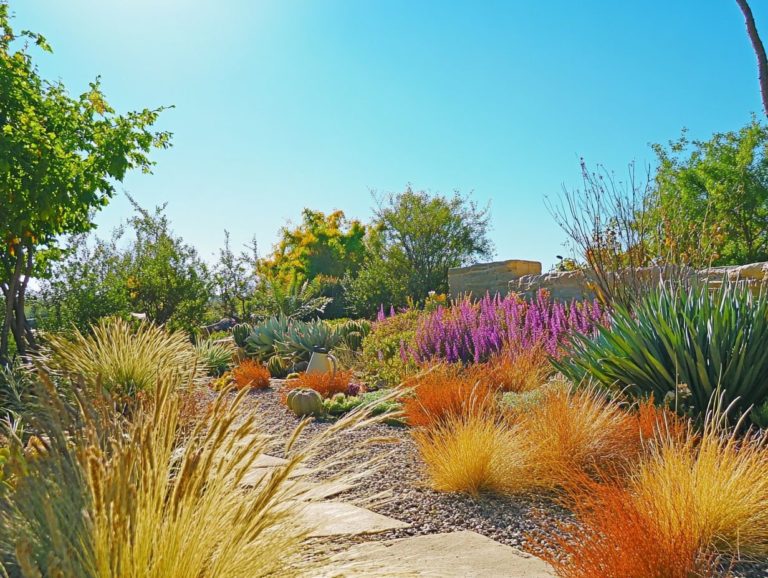Best Practices for Garden Layout in Drought
Drought presents formidable challenges for your garden, affecting plant health and soil quality. Understanding how drought impacts your landscape is essential for cultivating sustainable and resilient environments.
This article explores key factors for planning a garden that survives with little water, guiding you through selecting appropriate plants and implementing effective water conservation techniques.
It also introduces innovative design ideas aimed at maximizing water efficiency while keeping your garden vibrant.
Whether you re an experienced gardener or just starting out, these insights will help you create a flourishing oasis, even in dry conditions.
Contents
- Key Takeaways:
- Understanding Drought and Its Impact on Gardens
- Key Steps for Planning Your Drought-Resistant Garden!
- Designing a Drought-Resistant Garden Layout
- Maintaining a Drought-Resistant Garden
- Additional Tips for Gardeners in Drought-Prone Areas
- Frequently Asked Questions
- What are the best plants for a drought-prone garden?
- How can I save water in my garden during a drought?
- What spacing should I use for plants in a drought-tolerant garden?
- Should I include a lawn in a drought-prone garden?
- How can I improve my garden s soil for drought conditions?
- What are some design tips for a drought-prone garden?
Key Takeaways:
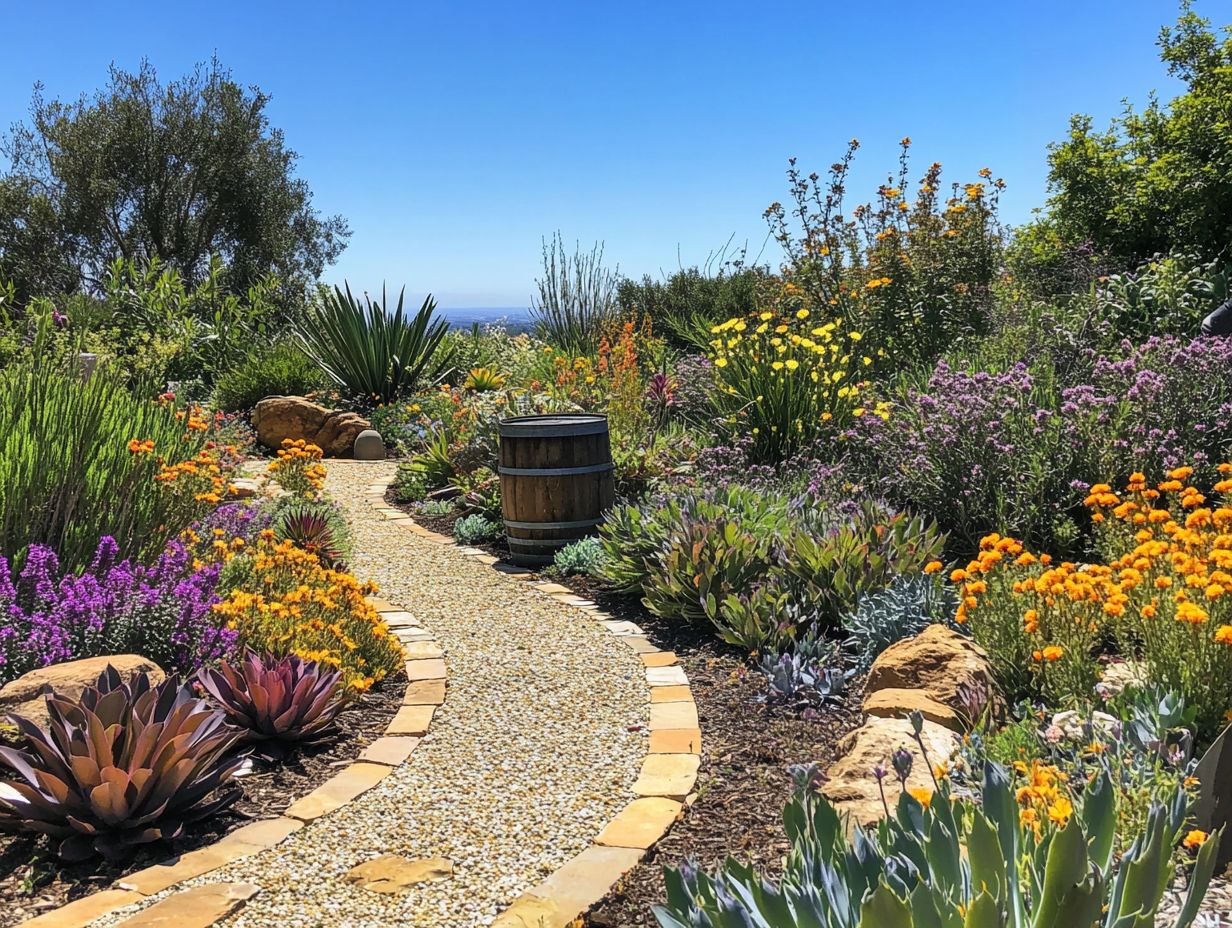
- Understanding the impact of drought on gardens is crucial for planning a successful garden that survives with little water.
- Soil quality, water conservation techniques, and choosing drought-resistant plants are key factors to consider when planning your garden.
- Incorporating water efficiency, shade, and windbreaks, along with proper watering and maintenance techniques, is essential for a thriving drought-resistant garden.
Understanding Drought and Its Impact on Gardens
Understanding drought and its impact on your garden is crucial for cultivating a flourishing home garden under challenging conditions. Drought, marked by extended periods of below-average rainfall, can significantly compromise plant health, soil quality, and overall garden productivity.
In areas like California, where drought conditions are common, adopting effective water conservation techniques is vital for maintaining soil health and supporting plants that survive with little water.
By embracing sustainable gardening principles and incorporating local native species, you can adapt your gardening practices to counter the adverse effects of drought effectively, including following the best practices for watering drought plants.
What Is Drought and How Does It Affect Gardens?
Drought is a prolonged stretch of abnormally low rainfall compared to historical averages. It can wreak havoc on your garden and plant life.
The causes of drought stem from a mix of natural and human-induced factors, including shifts in weather patterns and rising temperatures. During these dry spells, your garden may show signs of distress, such as wilting leaves and stunted growth. Vegetable gardens can take a hard hit, leading to reduced yields while flower gardens might lose their vibrancy as blooms begin to fade.
This shows why you need to implement water conservation strategies, such as mulching and efficient watering techniques. These practices help preserve soil health and sustain plant vitality during such trying times.
Key Steps for Planning Your Drought-Resistant Garden!
When planning a drought-resistant garden, several essential factors will ensure your garden flourishes even in water scarcity. For guidance, check out this resource on how to plan a drought-resistant garden layout.
The cornerstone of a successful drought garden is understanding soil quality and effective water conservation techniques. Utilizing best practices for vertical drought gardening with strategic planting methods that promote deep rooting and resilience in your plants is also important. Incorporating compost can enhance soil structure and water retention, crucial for maintaining plant health during dry spells.
Soil Quality and Water Conservation Techniques
Soil quality is essential for your drought-resistant garden’s success. It significantly influences water retention and plant health.
You can enhance this vital component by integrating organic materials and compost into the soil. This not only enriches nutrient levels but also boosts microbial activity, crucial for the overall health of your garden plants.
In addition to improving soil quality, effective water conservation practices ensure that every drop counts. For instance, applying mulch around your plants helps reduce evaporation and stabilize soil temperature. Creating a watering schedule tailored to your garden’s specific needs will optimize moisture retention, ensuring your plants receive necessary hydration without oversaturating the soil.
Start planning your drought-resistant garden today! Empower yourself to cultivate a thriving garden, even in challenging conditions.
Choosing Drought-Resistant Plants
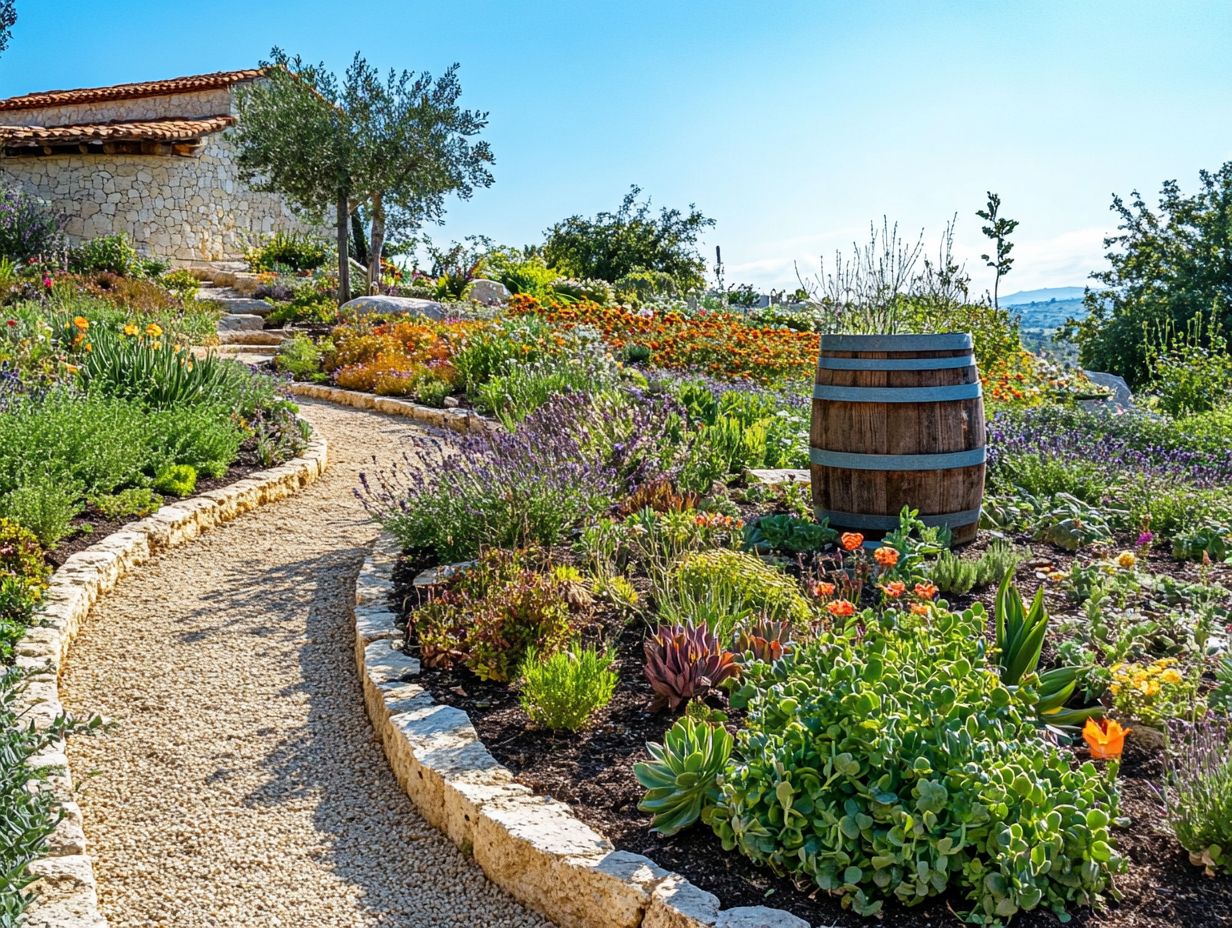
Choosing drought-resistant plants is an important step in creating a garden that thrives on minimal water. Many native California plants are exceptional choices for this endeavor.
These plants not only conserve water but also flourish in challenging conditions. This allows you to maintain a vibrant garden with little effort. For instance, consider Agave; its striking architectural form adds a unique elegance to your landscape while needing very little moisture.
Lavender, with its delightful fragrance and beautiful blooms, enhances the scenery while attracting pollinators. Culinary herbs like Sage and Rosemary are not just resilient; they also bring culinary delights to your kitchen.
When it comes to planting techniques, creating a balanced drought garden with deep, well-drained beds encourages robust root systems and helps plants withstand drought. This method supports the longevity of these plants and fosters a sustainable garden ecosystem. You can enjoy a flourishing garden with minimal upkeep!
Designing a Drought-Resistant Garden Layout
Designing an effective drought-resistant garden layout involves meticulous planning. Implementing best practices for urban drought gardening aims to maximize water efficiency while ensuring sustainable growth for your plants.
Each decision contributes to a harmonious balance between beauty and resource conservation. Your garden can thrive even in the driest conditions!
Maximizing Water Efficiency
Maximizing water efficiency in your drought-resistant garden is vital to keeping your plants thriving during dry spells. For more insights, check out the best strategies for budget drought gardening, which also helps minimize water waste.
To achieve this, explore various irrigation techniques that conserve water and encourage healthier plant growth. For example, implementing drip irrigation systems allows moisture to reach the roots directly, drastically reducing evaporation and making every drop count.
Setting up timed watering schedules enables you to water deeply during the cooler parts of the day. This further minimizes water loss to the sun s heat. By thoughtfully adapting these methods, you can cultivate a vibrant landscape while enhancing sustainability and preserving precious resources.
Incorporating Shade and Windbreaks
Incorporating shade and windbreaks into your garden design is an important method for protecting your drought-resistant plants from harsh environmental conditions. These structures shield your plants from scorching sunlight and help maintain moisture levels in the soil.
By strategically placing tall plants or trees as natural barriers, you can significantly reduce wind stress, which often increases water loss. Varieties like willows or poplars are particularly effective as they grow quickly and provide ample coverage.
Adding flowering shrubs such as lilacs or hydrangeas not only enhances biodiversity but also serves as excellent windbreaks. Thoughtfully integrating these elements into your landscape will elevate its visual appeal and cultivate a healthier garden ecosystem.
Maintaining a Drought-Resistant Garden
To successfully cultivate a drought-resistant garden, consistently focus on watering techniques, soil health, and the vitality of your plants. For detailed strategies on how to plan a drought-resistant garden layout, this ongoing attention is essential for achieving long-term success in your gardening endeavors.
Start your drought-resistant garden today and enjoy the benefits of a beautiful and sustainable landscape!
Proper Watering Techniques
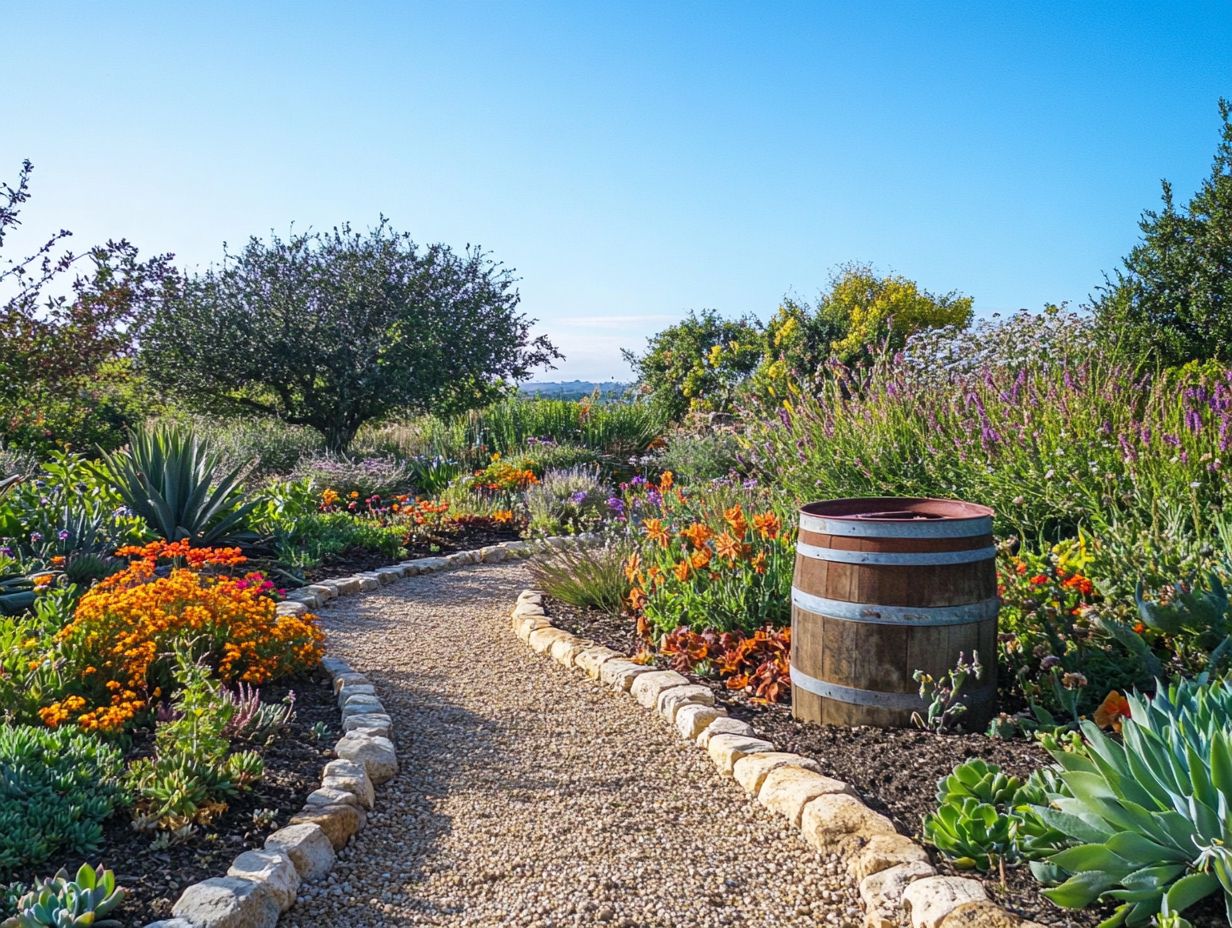
Proper watering techniques are crucial for maintaining a drought garden, as they ensure your plants receive the moisture they need without any waste. For more information, check out best practices for drought-resistant gardening.
In challenging conditions like this, using strategies such as deep watering can significantly benefit your plant roots. This encourages them to reach deeper into the soil in search of moisture.
You might also consider using moisture sensors to accurately gauge the needs of your plants. These sensors monitor soil moisture levels, allowing for more precise watering and making your efforts more effective.
Establishing an efficient watering schedule is vital to avoid the pitfalls of over or under-watering. This helps you conserve water while fostering healthier growth.
By understanding and implementing these techniques, you can create an environment where your plants thrive, even in arid conditions.
Managing Soil and Plant Health
Successfully managing soil and plant health is essential for cultivating a drought-resistant garden. It fosters resilience against challenges from the environment.
To achieve this, consider using compost and a variety of organic materials. They play a vital role in enriching your soil.
By incorporating nutrient-rich compost, you can enhance soil structure and fertility. This ensures your plants have access to essential minerals and water.
Regularly monitoring plant health is crucial. By observing signs of stress or nutrient deficiencies, you can make timely interventions.
Implementing practices such as crop rotation changing the type of plants grown in a specific area each season mulching, and cover cropping boosts soil biodiversity. It contributes to the overall vitality of your garden ecosystem.
This creates a balanced environment where your plants can thrive, even in challenging conditions.
Additional Tips for Gardeners in Drought-Prone Areas
For gardeners in drought-prone regions, tapping into supplementary resources and techniques, such as how to plan your garden for drought seasons, can greatly elevate both the sustainability and productivity of your garden.
Using Rainwater and Greywater
Using rainwater and greywater presents a highly effective strategy for water conservation. This significantly reduces your reliance on treated water sources for irrigation.
By adopting these sustainable practices, you can cultivate a thriving garden that not only fosters plant growth but also embodies a commitment to environmental stewardship.
Implementing a rainwater harvesting system typically involves setting up collection barrels or cisterns connected to downspouts. This captures precious runoff from your roof.
On the flipside, recycling greywater can be achieved by rerouting water from sinks or showers to your garden area through approved filtration systems.
This two-part approach helps you use more water while wasting less. Importantly, by incorporating these systems, you enhance the resilience of your garden during dry spells.
This ensures optimal moisture levels while simultaneously reducing water bills and your overall environmental footprint.
Community Resources and Support
Engaging with community resources can significantly enhance your knowledge and effectiveness in drought gardening.
Local community programs and educational workshops often provide invaluable insights into effective drought-resistant techniques. By participating in these initiatives, you can learn about native plants that require less water and discover efficient irrigation methods that suit your garden s needs.
Online platforms also offer a treasure trove of information, from webinars to discussion forums. Here, you can share experiences and strategies with fellow gardeners.
This collaborative atmosphere not only fosters a sense of community but also encourages sustainable practices, giving you the power to adapt your gardening methods for resilience against water scarcity.
Together, these resources equip you to tackle drought challenges with greater confidence. You can make a difference!
Frequently Asked Questions
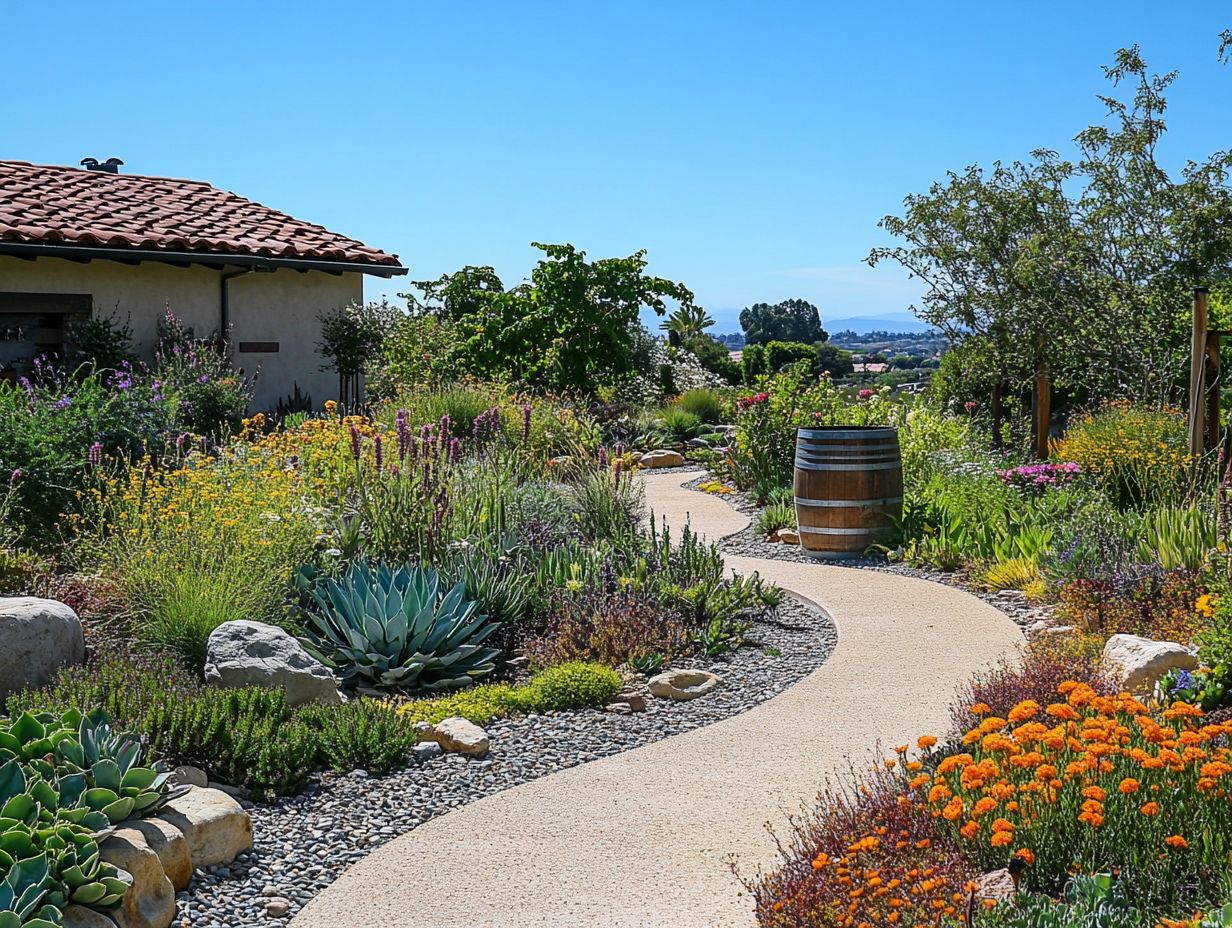
Take action today and start your drought gardening journey!
What are the best plants for a drought-prone garden?
Great choices include succulents and native plants. Drought-resistant options like lavender, rosemary, and sage thrive in dry conditions.
How can I save water in my garden during a drought?
Install a drip irrigation system to deliver water directly to the roots. Mulch your plants and collect rainwater to maximize moisture retention.
What spacing should I use for plants in a drought-tolerant garden?
Space plants wider apart than in traditional gardens. This improves air circulation and reduces competition for water.
Should I include a lawn in a drought-prone garden?
It s best to avoid a lawn or limit its size. Lawns need a lot of water to stay green, which can deplete resources during a drought.
How can I improve my garden s soil for drought conditions?
Add compost and mulch to help the soil retain moisture. Drought-resistant cover crops can also boost nutrients and improve structure.
What are some design tips for a drought-prone garden?
Group plants with similar water needs for efficiency. To enhance your garden’s resilience, consider learning how to plan a drought-resistant community garden, create shade and wind barriers, and use rocks and gravel to minimize water usage.


